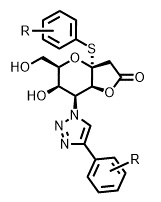De novo design of talo-configured lactones as a new class of highly potent, selective, and orally bioavailable galectin-3 inhibitors
Galectins - a family of glycan-binding proteins - are involved in many different biological processes, such as inflammation, apoptosis, angiogenesis, fibrosis, immunomodulation, or tumor proliferation. Their carbohydrate-recognition domain (CRD) binds to a b-galactopyranose unit present in many glycoproteins on the cell surface. Crystal structures of galectin-3 with various ligands have revealed that its CRD is characterized by a relatively large but shallow, polar, crater-shaped, and solvent accessible binding site that accommodates many water molecules. Upon binding of an oligosaccharide containing a galactose moiety, some of these water molecules are replaced by the galactose OH-groups in a highly directional fashion, some of them playing an integrative role in the stabilization of the ligand-protein complex. The galectin-3 binders known today all represent galactopyranose derivatives. While they incorporate modifications at the 1, 2, and 3-position of the galactopyranose moiety, they strictly conserve the highly directional interactions of the galactose 4-OH and 6-OH groups with the protein. Because of that, all potent galectin-3 binders have at least two OH-groups conserved, a feature that can limit their permeability across biological membranes.
For the above-mentioned reasons, the design of small, potent and orally bioavailable galectin-3 inhibitors remains a great challenge in medicinal chemistry.
Based on these observations, we concluded that a detailed understanding of the binding mode at an atomic level and precise information about the hydrogen-bond network of the ligand-protein complex are essential for a successful design of potent and selective galectin-3 inhibitors. We therefore based our de novo design of galectin-3 inhibitors on X-ray crystallography, isothermal titration calorimetry and molecular dynamics simulations, and combined these methods with physico-chemical and DMPK characterization of the prepared molecules. In our talk, we will illustrate the path that led to the discovery of talo-configured lactones as a new series of highly potent, selective, and orally bioavailable galectin-3 inhibitors.
